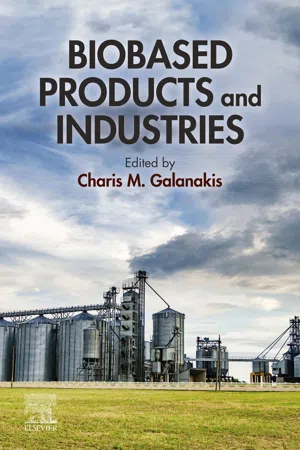
Biobased Products and Industries
Charis M. Galanakis
- 434 Seiten
- English
- ePUB (handyfreundlich)
- Über iOS und Android verfügbar
Biobased Products and Industries
Charis M. Galanakis
Über dieses Buch
Biobased Products and Industries fills the gap between academia and industry by covering all the important aspects of biobased products and their relevant industries in one single reference. Highlighting different perspectives of the bioeconomy, EU relevant projects, as well as the environmental impact of biobased materials and sustainability, the book covers biobased polymers, plastics, nanocomposites, packaging materials, electric devices, biofuels, textiles, consumer goods, and biocatalysis for the decarboxylation and decarboxylation of biobased molecules, including biobased products from alternative sources (algae) and the biobased production of chemicals through metabolic engineering.
Focusing on the most recent advances in the field, the book also analyzes the potentiality of already commercialized processes and products.
- Highlights the important aspects of biobased products as well as their relevant industries in one single reference
- Focuses on the most recent advances in the field, analyzing the potentiality of already commercialized processes and products
- Provides an ideal resource for anyone dealing with bioresource technology, biomass valorization and new products development
Häufig gestellte Fragen
Information
Overview of bio-based industries
Abstract
Keywords
1.1. Introduction
Inhaltsverzeichnis
- Cover image
- Title page
- Table of Contents
- Copyright
- Contributors
- Foreword
- Preface
- Chapter 1. Overview of bio-based industries
- Chapter 2. Development perspectives for the bio-based economy
- Chapter 3. Government regulation of bio-based fuels and chemicals
- Chapter 4. Biofuels
- Chapter 5. Bio-based production of chemicals through metabolic engineering
- Chapter 6. Algae for the production of bio-based products
- Chapter 7. Bio-based products from wood materials
- Chapter 8. Bio-based packaging materials
- Chapter 9. Bio-based electric devices
- Chapter 10. Bio-based textile coatings and composites
- Index